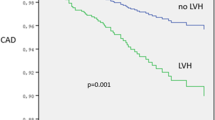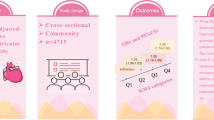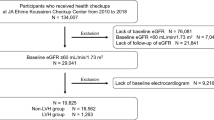Abstract
Left ventricular hypertrophy (LVH) is a significant risk factor for cardiovascular mortality and morbidity in patients with hypertension. However, the effect of age on LVH regression or persistence and its differential prognostic value remain unclear. Therefore, we investigated the clinical implications of LVH regression in 1847 patients with hypertension and echocardiography data (at baseline and during antihypertensive treatment at an interval of 6–18 months) according to age. LVH was defined as a left ventricular mass index (LVMI) > 115 g/m2 and >95 g/m2 in men and women, respectively. LVH prevalence at baseline was not different according to age (age < 65 years: 42.6%; age ≥65 years: 45.7%; p = 0.187), but LVH regression was more frequently observed in the younger group (36.4% vs. 27.5%; p = 0.008). Spline curves and multiple linear regression analysis showed a significant relationship between reductions in systolic blood pressure and LVMI in the younger group (β = 0.425; p < 0.001), but not the elderly group (β = 0.044; p = 0.308). LVH regression was associated with a lower risk of the study outcome (composite of cardiovascular death and hospitalization for heart failure) regardless of age. In conclusion, the association between the reduction in blood pressure and LVH regression was prominent in patients with age < 65 years, but not in those with age ≥65 years. However, an association between LVH regression and lower risk of cardiovascular death and hospitalization for heart failure was observed regardless of patient age, suggesting the prognostic value of the LVH regression not only in the younger patients but also in elderly patients.

This is a preview of subscription content, access via your institution
Access options
Subscribe to this journal
Receive 12 print issues and online access
$259.00 per year
only $21.58 per issue
Buy this article
- Purchase on Springer Link
- Instant access to full article PDF
Prices may be subject to local taxes which are calculated during checkout



Similar content being viewed by others
References
Dolgin M. Nomenclature and Criteria for Diagnosis of Diseases of the Heart and Great Vessels. 1994.
Summary of 1993 World Health Organisation-International Society of Hypertension guidelines for the management of mild hypertension. Subcommittee of WHO/ISH Mild Hypertension Liaison committee. BMJ. 1993;307:1541–46.
Savage DD, Garrison RJ, Kannel WB, Levy D, Anderson SJ, Stokes J 3rd, et al. The spectrum of left ventricular hypertrophy in a general population sample: the Framingham Study. Circulation 1987;75:I26–33.
Iriarte M, Murga N, Sagastagoitia D, Morillas M, Boveda J, Molinero E, et al. Classification of hypertensive cardiomyopathy. Eur Heart J 1993;14:95–101.
Alegria-Ezquerra E, Gonzalez-Juanatey JR, Gonzalez-Maqueda I. [Hypertensive heart disease: a proposed clinical classification]. Rev Esp Cardiol. 2006;59:398–9.
Lorell BH, Carabello BA. Left ventricular hypertrophy: pathogenesis, detection, and prognosis. Circulation. 2000;102:470–9.
Levy D, Murabito JM, Anderson KM, Christiansen JC, Castelli WP. Echocardiographic left ventricular hypertrophy: clinical characteristics. The Framingham Heart Study. Clin Exp Hypertens A. 1992;14:85–97.
Vakili BA, Okin PM, Devereux RB. Prognostic implications of left ventricular hypertrophy. Am Heart J. 2001;141:334–41.
Devereux RB, Wachtell K, Gerdts E, Boman K, Nieminen MS, Papademetriou V, et al. Prognostic significance of left ventricular mass change during treatment of hypertension. JAMA. 2004;292:2350–6.
Gerdts E, Cramariuc D, de Simone G, Wachtell K, Dahlof B, Devereux RB. Impact of left ventricular geometry on prognosis in hypertensive patients with left ventricular hypertrophy (the LIFE study). Eur J Echocardiogr. 2008;9:809–15.
Verdecchia P. Prognostic value of ambulatory blood pressure : current evidence and clinical implications. Hypertension. 2000;35:844–51.
Verdecchia P, Angeli F, Gattobigio R, Guerrieri M, Benemio G, Porcellati C. Does the reduction in systolic blood pressure alone explain the regression of left ventricular hypertrophy? J Hum Hypertens. 2004;18(Suppl 2):S23–28.
Gosse P, Sheridan DJ, Zannad F, Dubourg O, Gueret P, Karpov Y, et al. Regression of left ventricular hypertrophy in hypertensive patients treated with indapamide SR 1.5 mg versus enalapril 20 mg: the LIVE study. J Hypertens. 2000;18:1465–75.
Fouad FM, Nakashima Y, Tarazi RC, Salcedo EE. Reversal of left ventricular hypertrophy in hypertensive patients treated with methyldopa: lack of association with blood pressure control. Am J Cardiol. 1982;49:795–801.
Villevalde S, Safarova A, Vorobyeva M, Kobalava Z. Changes of appropriateness of left ventricular mass during antihypertensive treatment: Pp.23.224. J Hypertension. 2011;29:e358–e359.
Gerdts E, Roman M, Palmieri V, Wachtell K, Smith G, Nieminen MS, et al. Impact of age on left ventricular hypertrophy regression during antihypertensive treatment with losartan or atenolol (the LIFE study). J Hum Hypertension. 2004;18:417–22.
Lonnebakken MT, Izzo R, Mancusi C, Gerdts E, Losi MA, Canciello G, et al. Left ventricular hypertrophy regression during antihypertensive treatment in an outpatient clinic (the Campania Salute Network). J Am Heart Assoc. 2017;6:e004152.
Kim HM, Hwang IC, Choi HM, Yoon YE, Cho GY. Prognostic implication of left ventricular hypertrophy regression after antihypertensive therapy in patients with hypertension. Front Cardiovasc Med. 2022;9:1082008.
Lang RM, Badano LP, Mor-Avi V, Afilalo J, Armstrong A, Ernande L, et al. Recommendations for cardiac chamber quantification by echocardiography in adults: an update from the American Society of Echocardiography and the European Association of Cardiovascular Imaging. J Am Soc Echocardiogr. 2015;28:1–39.e14.
Gonzalez A, Ravassa S, Lopez B, Moreno MU, Beaumont J, San Jose G, et al. Myocardial remodeling in hypertension. Hypertension. 2018;72:549–58.
de Simone G, Devereux RB, Izzo R, Girfoglio D, Lee ET, Howard BV, et al. Lack of reduction of left ventricular mass in treated hypertension: the strong heart study. J Am Heart Assoc. 2013;2:e000144.
Lopez B, Ravassa S, Moreno MU, Jose GS, Beaumont J, Gonzalez A, et al. Diffuse myocardial fibrosis: mechanisms, diagnosis and therapeutic approaches. Nat Rev Cardiol. 2021;18:479–98.
Hwang IC, Kim HK, Park JB, Park EA, Lee W, Lee SP, et al. Aortic valve replacement-induced changes in native T1 are related to prognosis in severe aortic stenosis: T1 mapping cardiac magnetic resonance imaging study. Eur Heart J Cardiovasc Imaging. 2020;21:653–63.
Treibel TA, Kozor R, Schofield R, Benedetti G, Fontana M, Bhuva AN, et al. Reverse myocardial remodeling following valve replacement in patients with aortic stenosis. J Am Coll Cardiol. 2018;71:860–71.
Rodrigues JC, Amadu AM, Dastidar AG, Szantho GV, Lyen SM, Godsave C, et al. Comprehensive characterisation of hypertensive heart disease left ventricular phenotypes. Heart. 2016;102:1671–9.
Rudolph A, Abdel-Aty H, Bohl S, Boye P, Zagrosek A, Dietz R, et al. Noninvasive detection of fibrosis applying contrast-enhanced cardiac magnetic resonance in different forms of left ventricular hypertrophy relation to remodeling. J Am Coll Cardiol. 2009;53:284–91.
Liu T, Song D, Dong J, Zhu P, Liu J, Liu W, et al. Current understanding of the pathophysiology of myocardial fibrosis and its quantitative assessment in heart failure. Front Physiol. 2017;8:238.
Diez J, Lopez B, Gonzalez A, Querejeta R. Clinical aspects of hypertensive myocardial fibrosis. Curr Opin Cardiol. 2001;16:328–35.
Cuspidi C, Ciulla M, Zanchetti A. Hypertensive myocardial fibrosis. Nephrol Dial Transpl. 2006;21:20–23.
Kannel WB, Sorlie P Left Ventricular Hypertrophy in Hypertension: Prognostic and Pathogenetic Implications (The Framingham Study). Paper presented at: The Heart in Hypertension; 1981//, 1981; Berlin, Heidelberg.
Levy D, Garrison RJ, Savage DD, Kannel WB, Castelli WP. Prognostic implications of echocardiographically determined left ventricular mass in the Framingham Heart Study. N. Engl J Med. 1990;322:1561–6.
Zhang W, Zhang S, Deng Y, Wu S, Ren J, Sun G, et al. Trial of intensive blood-pressure control in older patients with hypertension. N Engl J Med. 2021;385:1268–79.
Collaboration NCDRF. Worldwide trends in hypertension prevalence and progress in treatment and control from 1990 to 2019: a pooled analysis of 1201 population-representative studies with 104 million participants. Lancet. 2021;398:957–80.
Soenarta AA, Buranakitjaroen P, Chia YC, Chen CH, Nailes J, Hoshide S, et al. An overview of hypertension and cardiac involvement in Asia: Focus on heart failure. J Clin Hypertens (Greenwich). 2020;22:423–30.
Hoshide S, Yamamoto K, Katsurada K, Yano Y, Nishiyama A, Wang J-G, et al. Agreement regarding overcoming hypertension in the Asian Hypertension Society Network 2022. Hypertension Res. 2023;46:3–8.
Kario K, Chia YC, Sukonthasarn A, Turana Y, Shin J, Chen CH, et al. Diversity of and initiatives for hypertension management in Asia-Why we need the HOPE Asia Network. J Clin Hypertens (Greenwich). 2020;22:331–43.
Hwang IC, Kim CH, Kim JY, Choi HM, Yoon YE, Cho GY. Rate of change in 10-year atherosclerotic cardiovascular disease risk and its implications for primary prevention. Hypertension. 2023;80:1697–706.
Dai H, Bragazzi NL, Younis A, Zhong W, Liu X, Wu J, et al. Worldwide trends in prevalence, mortality, and disability-adjusted life years for hypertensive heart disease from 1990 to 2017. Hypertension. 2021;77:1223–33.
Chahal N, Lim T, Jain P, Chambers J, Kooner J, Senior R. The increased prevalence of left ventricular hypertrophy and concentric remodeling in UK Indian Asians compared with European Whites. J Hum Hypertension. 2013;27:288–93.
Santhanakrishnan R, Wang N, Larson MG, Magnani JW, Vasan RS, Wang TJ, et al. Racial differences in electrocardiographic characteristics and prognostic significance in whites versus asians. J Am Heart Assoc. 2016;5:e002956.
Cuspidi C, Tadic M. Left ventricular hypertrophy in hypertension: need of ethnic-specific criteria. J Clin Hypertens (Greenwich). 2022;24:1530–1.
Akintoye E, Mahmoud K, Shokr M, Sandio A, Mallikethi-Reddy S, Sheikh M, et al. Racial/ethnic differences in the prognostic utility of left ventricular mass index for incident cardiovascular disease. Clin Cardiol. 2018;41:502–9.
Acknowledgements
We thank Lia Ju, a registered diagnostic cardiac sonographer (RDCS), and Eun-Ju Choi, a research nurse, for their dedication and support.
Author information
Authors and Affiliations
Corresponding authors
Ethics declarations
Conflict of interest
The authors declare no competing interests.
Additional information
Publisher’s note Springer Nature remains neutral with regard to jurisdictional claims in published maps and institutional affiliations.
Supplementary Information
Rights and permissions
Springer Nature or its licensor (e.g. a society or other partner) holds exclusive rights to this article under a publishing agreement with the author(s) or other rightsholder(s); author self-archiving of the accepted manuscript version of this article is solely governed by the terms of such publishing agreement and applicable law.
About this article
Cite this article
Chu, HW., Hwang, IC., Kim, H.M. et al. Age-dependent implications of left ventricular hypertrophy regression in patients with hypertension. Hypertens Res 47, 1144–1156 (2024). https://doi.org/10.1038/s41440-023-01571-w
Received:
Revised:
Accepted:
Published:
Issue Date:
DOI: https://doi.org/10.1038/s41440-023-01571-w



